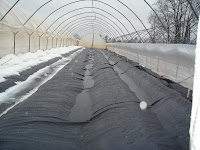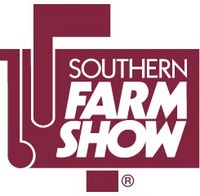 No matter what the forecast says, spring is coming. Along with it, come greater management needs. Strawberries have been in the ground since last fall and are the first fruit crop harvested in spring. The cold winter has meant most of our plants have been under row cover for at least part of the winter and our arthropod (insect and mite) issues have been out of sight and out of mind.
No matter what the forecast says, spring is coming. Along with it, come greater management needs. Strawberries have been in the ground since last fall and are the first fruit crop harvested in spring. The cold winter has meant most of our plants have been under row cover for at least part of the winter and our arthropod (insect and mite) issues have been out of sight and out of mind. Row covered strawberries at Vollmer Farms, Bunn, NC. Spring, 2009.
Row covered strawberries at Vollmer Farms, Bunn, NC. Spring, 2009.1. Scout for aphids, but only treat if populations are high. Aphids can rapidly proliferate under row covers, but unless early spring populations are causing sooty mold build up, treatment is likely not needed. Later spring and summer populations are often kept under good biological control in NC. If aphid populations under the covers are producing sooty mold and exceed 10 aphids/newly expanded leaf on average, treatment may be justified. If systemic insecticides are your aphid management tool of choice, the time to use these is now (before covers come off). Once blooms are exposed to bees, the labeled systemic materials for aphids in strawberries can no longer be used.
2. Begin spider mite sampling. Spider mites are the key arthropod pest in southeastern strawberries. Mite activity is typically lower in winter months, but as temperatures warm, spider mites will become more active and reproduce faster. We are currently studying the impact of long term row cover on overwintering mite populations, but our working assumption is that row covers potentially increase mite populations over the winter. This winter, of course, all bets are off. It is important to track mite populations closely and be prepared to treat when they reach our recommended treatment threshold (5 mites/leaflet). This threshold is based on a random sample of 10 leaflets/acre. It is in grower's best interest to treat at threshold levels and not on a schedule basis, because virtually all of the labeled miticides have restrictions on the number of applications and/or amount of active ingredient that can be applied to strawberries per season. We want to keep as many good options in our tool box for as long as possible.
 Phytoseiulus persimilis, one of the commercially available biological control agents for spider mites. Image from UC IPM.
Phytoseiulus persimilis, one of the commercially available biological control agents for spider mites. Image from UC IPM.Biological control is also an option for spider mites, but we are in the process of optimizing methods for NC and do not have concrete recommendations at this time.
I have heard a lot of rumblings about different materials being applied systemically for mites, and I want to be perfectly clear: There are no systemic miticides. None of the materials currently labeled for soil or drip applications in strawberries are either registered for or effective against spider mites. Our best chemical control for mites is over the top treatments of miticides. I also do not recommend the use of pyrethriod insecticides against mites. The pyrethriods registered in strawberries have either shown no effect in our trials or have actually increased mite populations because they are equally toxic to beneficial insects.
 Strawberry clipper damage in Lee County, NC, 2009. Photo from Stephanie Romelczyk, Lee County Horticulture Agent.
Strawberry clipper damage in Lee County, NC, 2009. Photo from Stephanie Romelczyk, Lee County Horticulture Agent.You can find more specific information about pesticides in the NC Ag Chem Manual and the Southeastern Strawberry IPM Guide.
I will post a mid season arthropod reminder for strawberries in May which will cover late season mite management, sap beetles, thrips, and the unusual occasionals we see as the weather gets warmer.








